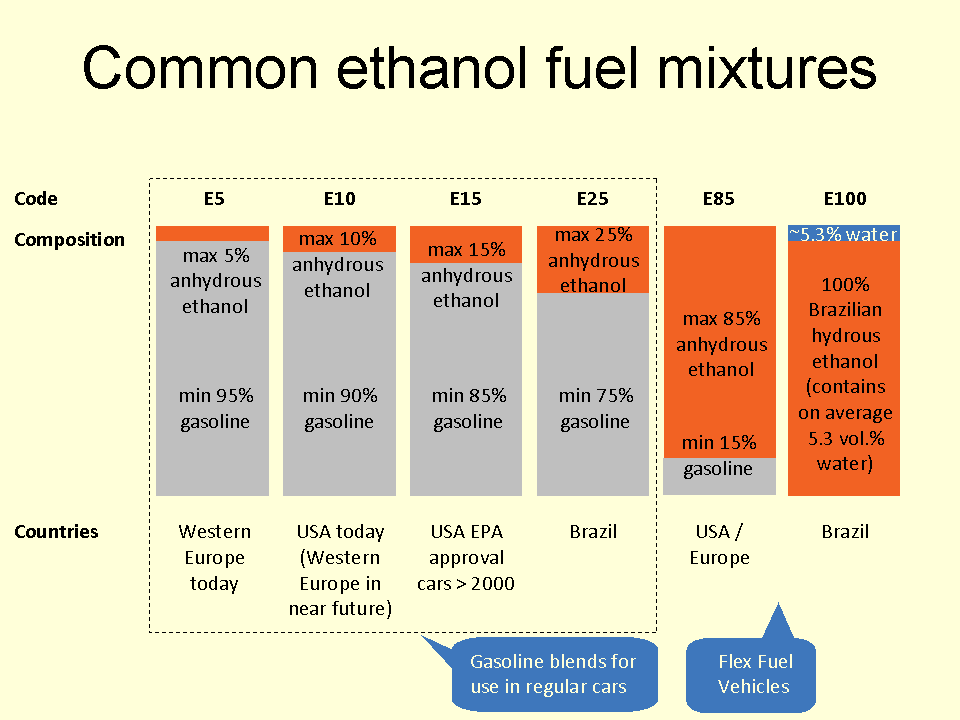|
Biofuel In The United States
The United States produces mainly biodiesel and ethanol fuel, which uses corn as the main feedstock. The US is the world's largest producer of ethanol, having produced nearly 16 billion gallons in 2017 alone. The United States, together with Brazil accounted for 85% of all ethanol production, with total world production of 27.05 billion gallons. Biodiesel is commercially available in most oilseed-producing states. , it was somewhat more expensive than fossil diesel, though it is still commonly produced in relatively small quantities, in comparison to petroleum products and ethanol fuel. Biofuels are mainly used mixed with fossil fuels. They are also used as additives. The largest biodiesel consumer is the U.S. Army. Most light vehicles on the road today in the US can run on blends of up to 10% ethanol, and motor vehicle manufacturers already produce vehicles designed to run on much higher ethanol blends. The demand for bioethanol fuel in the United States was stimulated by the ... [...More Info...] [...Related Items...] OR: [Wikipedia] [Google] [Baidu] |
United States
The United States of America (USA), also known as the United States (U.S.) or America, is a country primarily located in North America. It is a federal republic of 50 U.S. state, states and a federal capital district, Washington, D.C. The 48 contiguous states border Canada to the north and Mexico to the south, with the semi-exclave of Alaska in the northwest and the archipelago of Hawaii in the Pacific Ocean. The United States asserts sovereignty over five Territories of the United States, major island territories and United States Minor Outlying Islands, various uninhabited islands in Oceania and the Caribbean. It is a megadiverse country, with the world's List of countries and dependencies by area, third-largest land area and List of countries and dependencies by population, third-largest population, exceeding 340 million. Its three Metropolitan statistical areas by population, largest metropolitan areas are New York metropolitan area, New York, Greater Los Angeles, Los Angel ... [...More Info...] [...Related Items...] OR: [Wikipedia] [Google] [Baidu] |
Energy Information Administration
The U.S. Energy Information Administration (EIA) is a principal agency of the U.S. Federal Statistical System responsible for collecting, analyzing, and disseminating energy information to promote sound policymaking, efficient markets, and public understanding of energy and its interaction with the economy and the environment. EIA programs cover data on coal, petroleum, natural gas, electric, renewable and nuclear energy. EIA is part of the U.S. Department of Energy. Background The Department of Energy Organization Act of 1977 established EIA as the primary federal government authority on energy statistics and analysis, building upon systems and organizations first established in 1974 following the oil market disruption of 1973. EIA conducts a comprehensive data collection program that covers the full spectrum of energy sources, end uses, and energy flows; generates short- and long-term domestic and international energy projections; and performs informative energy analyses ... [...More Info...] [...Related Items...] OR: [Wikipedia] [Google] [Baidu] |
E15 Fuel
Several common ethanol fuel mixtures are in use around the world. The use of pure anhydrous, hydrous or anhydrous ethanol in internal combustion engines (ICEs) is only possible if the engines are designed or modified for that purpose, and used only in automobiles, light-duty trucks and motorcycles. Anhydrous ethanol can be blended with :gasoline (petrol) for use in gasoline engines, but with high ethanol content only after engine modifications to meter increased fuel volume since pure ethanol contains only 2/3 of the BTUs of an equivalent volume of pure gasoline. High percentage ethanol mixtures are used in some racing engine applications as the very high octane rating of ethanol is compatible with very high compression ratios. Ethanol fuel mixtures have "E" numbers which describe the percentage of ethanol fuel in the mixture by volume, for example, E85 is 85% anhydrous ethanol and 15% gasoline. Low-ethanol blends are typically from E5 to E25, although internationally the most c ... [...More Info...] [...Related Items...] OR: [Wikipedia] [Google] [Baidu] |
Renewable Identification Number
A Renewable Identification Number (or RIN) is a serial number assigned to a batch of biofuel for the purpose of tracking its production, use, and trading as required by the United States Environmental Protection Agency's Renewable Fuel Standard (RFS) implemented according to the Energy Policy Act of 2005 and the Energy Independence and Security Act of 2007. RIN components As defined in the regulation: Under RFS2, each batch-RIN generated will continue to uniquely identify not only a specific batch of renewable fuel, but also every gallon-RIN assigned to that batch. Thus the RIN will continue to be defined as follows: RIN: KYYYYCCCCFFFFFBBBBBRRDSSSSSSSSEEEEEEEE Where: * K = Code distinguishing assigned RINs from separated RINs * YYYY = Calendar year of production or import * CCCC = Company ID * FFFFF = Facility ID * BBBBB = Batch number * RR = Code identifying the Equivalence Value * D = Code identifying the renewable fuel category * SSSSSSSS = Start of RIN block * EEEEEEEE = End o ... [...More Info...] [...Related Items...] OR: [Wikipedia] [Google] [Baidu] |
Energy Independence And Security Act Of 2007
The Energy Independence and Security Act of 2007Pub.L. 110-140, originally named the Clean Energy Act of 2007, is an Act of Congress concerning the energy policy of the United States. As part of the United States Democratic Party, Democratic Party's 100-Hour Plan during the 110th United States Congress, 110th Congress, it was introduced in the United States House of Representatives by Representative Nick Rahall of West Virginia, along with 198 cosponsors. Even though Rahall was 1 of only 4 Democrats to oppose the final bill, it passed in the House without amendment in January 2007. When the Act was introduced in the United States Senate, Senate in June 2007, it was combined with Senate Bill S. 1419: ''Renewable Fuels, Consumer Protection, and Energy Efficiency Act of 2007''. This amended version passed the Senate on June 21, 2007. After further amendments and negotiation between the House and Senate, a revised bill passed both houses on December 18, 2007 and President George W. ... [...More Info...] [...Related Items...] OR: [Wikipedia] [Google] [Baidu] |
Center For American Progress
The Center for American Progress (CAP) is a public policy think tank, research and advocacy organization which presents a Modern liberalism in the United States, liberal viewpoint on Economic policy, economic and social issues. CAP is headquartered in Washington, D.C. The president and chief executive officer of CAP is Neera Tanden, a Democratic political consultant and former government official. The first president and CEO was John Podesta, who has served as White House Chief of Staff to President of the United States, US President Bill Clinton and as the chairman of the 2016 presidential campaign of Hillary Clinton. Podesta remained with the organization as chairman of the board until he joined the Obama Executive Office of the President, White House staff in December 2013. The Center for American Progress has a youth-engagement organization, Generation Progress, and a sister advocacy organization, the Center for American Progress Action Fund (CAPAF). History and mission The ... [...More Info...] [...Related Items...] OR: [Wikipedia] [Google] [Baidu] |
Worldwatch Institute
The Worldwatch Institute was a globally focused environmental research organization based in Washington, D.C., founded by Lester R. Brown. Worldwatch was named as one of the top ten sustainable development research organizations by Globescan Survey of Sustainability Experts. Brown left to found the Earth Policy Institute in 2000. The institute terminated in 2017, after publication of its last '' State of the World Report''. Worldwatch.org was unreachable from mid 2019. Mission The mission of the Institute read: "Through research and outreach that inspire action, the Worldwatch Institute works to accelerate the transition to a sustainable world that meets human needs. The Institute's top mission objectives are universal access to renewable energy and nutritious food, expansion of environmentally sound jobs and development, transformation of cultures from consumerism to sustainability, and an early end to population growth through healthy and intentional childbearing." The ... [...More Info...] [...Related Items...] OR: [Wikipedia] [Google] [Baidu] |
United States Clean Air Act
The Clean Air Act (CAA) is the United States' primary federal air quality law, intended to reduce and control air pollution nationwide. Initially enacted in 1963 and amended many times since, it is one of the United States' first and most influential modern environmental laws. As with many other major U.S. federal environmental statutes, the Clean Air Act is administered by the U.S. Environmental Protection Agency (EPA), in coordination with state, local, and tribal governments. EPA develops extensive administrative regulations to carry out the law's mandates. Associated regulatory programs, which are often technical and complex, implement these regulations. Among the most important, the National Ambient Air Quality Standards program sets standards for concentrations of certain pollutants in outdoor air, and the National Emissions Standards for Hazardous Air Pollutants program which sets standards for emissions of particular hazardous pollutants from specific sources. Other ... [...More Info...] [...Related Items...] OR: [Wikipedia] [Google] [Baidu] |
Energy Policy Act Of 2005
The Energy Policy Act of 2005 () is a federal law signed by President George W. Bush on August 8, 2005, at Sandia National Laboratories in Albuquerque, New Mexico. The act, described by proponents as an attempt to combat growing energy problems, changed US energy policy by providing Energy subsidies#Allocation of subsidies in the United States, tax incentives and loan guarantees for energy production of various types. The most consequential aspect of the law was to greatly increase ethanol production to be blended with gasoline. The law also repealed the Public Utility Holding Company Act of 1935, effective February 2006. Provisions General provisions * The Act increases the amount of biofuel (usually ethanol) that must be mixed with gasoline sold in the United States to by 2006, by 2009 and by 2012; two years later, the Energy Independence and Security Act of 2007 extended the target to by 2022. * Under an amendment in the American Recovery and Reinvestment Act of 2009, ... [...More Info...] [...Related Items...] OR: [Wikipedia] [Google] [Baidu] |
Renewable Fuel Standard
The Renewable Fuel Standard (RFS) is an American federal program that requires transportation fuel sold in the United States to contain a minimum volume of renewable fuels. It originated with the Energy Policy Act of 2005 and was expanded and extended by the Energy Independence and Security Act of 2007. Research published by the Government Accountability Office in November 2016 found the program unlikely to meet its goal of reducing greenhouse gas emissions due to limited current and expected future production of advanced biofuels. History The RFS requires renewable fuel to be blended into transportation fuel in increasing amounts each year, escalating to 36 billion gallons by 2022. Each renewable fuel category in the RFS must emit lower levels of greenhouse gases relative to the petroleum fuel it replaces. The first RFS, usually referred to as RFS1, required that 4 billion gallons of biofuel be used in 2006. This requirement was scheduled to rise to 7.5 billion gallons in 2012 ... [...More Info...] [...Related Items...] OR: [Wikipedia] [Google] [Baidu] |
National Renewable Energy Laboratory
The National Renewable Energy Laboratory (NREL) in the US specializes in the research and development of renewable energy, energy efficiency, energy systems integration, and sustainable transportation. NREL is a federally funded research and development center sponsored by the Department of Energy and operated by the Alliance for Sustainable Energy, a joint venture between MRIGlobal and Battelle. Located in Golden, Colorado, NREL is home to the National Center for Photovoltaics, the National Bioenergy Center, and the National Wind Technology Center. History Establishment During the 1973 oil crisis, soaring energy prices caused gasoline shortages and contributed significantly to inflation. US President Gerald Ford openly recognized the need for greater energy independence at the September 1974 World Energy Conference in Detroit. A month later, the Solar Energy Research, Development and Demonstration Act of 1974 was signed. Section 10 of the bill explicitly outlined ... [...More Info...] [...Related Items...] OR: [Wikipedia] [Google] [Baidu] |
1979 Energy Crisis
A drop in oil production in the wake of the Iranian revolution led to an energy crisis in 1979. Although the global oil supply only decreased by approximately four percent, the oil markets' reaction raised the price of crude oil drastically over the next 12 months, more than doubling it to . The sudden increase in price was connected with fuel shortages similar to the 1973 oil crisis. In 1980, following the onset of the Iran–Iraq War, oil production in Iran fell drastically. Iraq's oil production also dropped significantly, triggering economic recessions worldwide. Oil prices did not return to pre-crisis levels until the mid-1980s. Oil prices after 1980 began a steady decline over the next 20 years, except for a brief uptick during the Gulf War, which then reached a 60% fall-off in the 1990s. Mexico, Nigeria, and Venezuela's major oil exporters expanded their production during this time. The Soviet Union became the largest oil producer in the world, and oil from the N ... [...More Info...] [...Related Items...] OR: [Wikipedia] [Google] [Baidu] |






